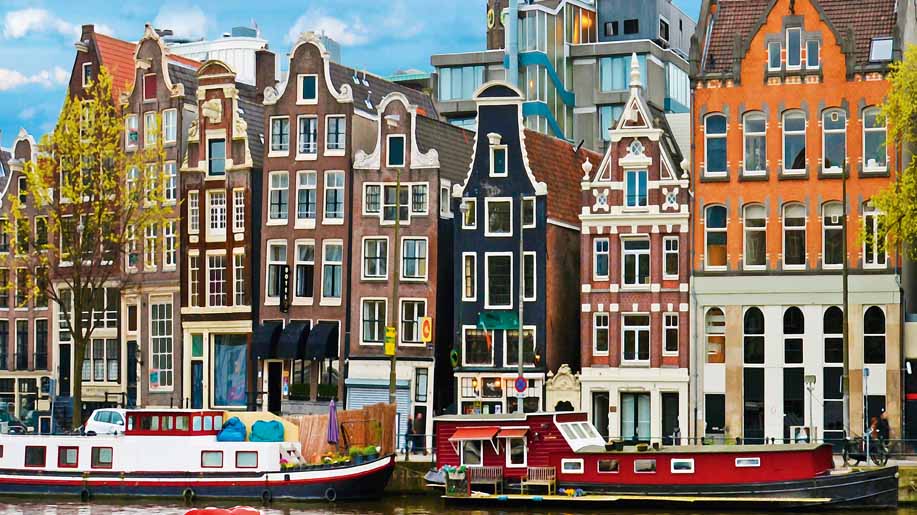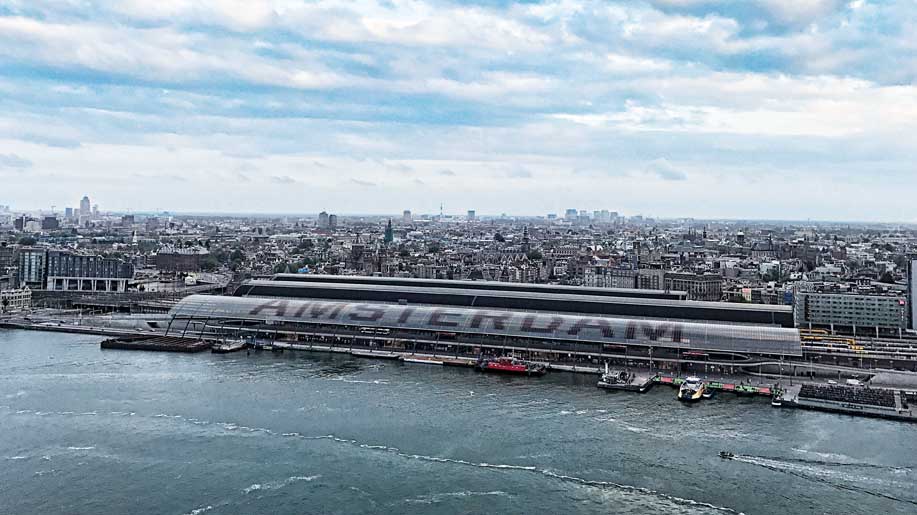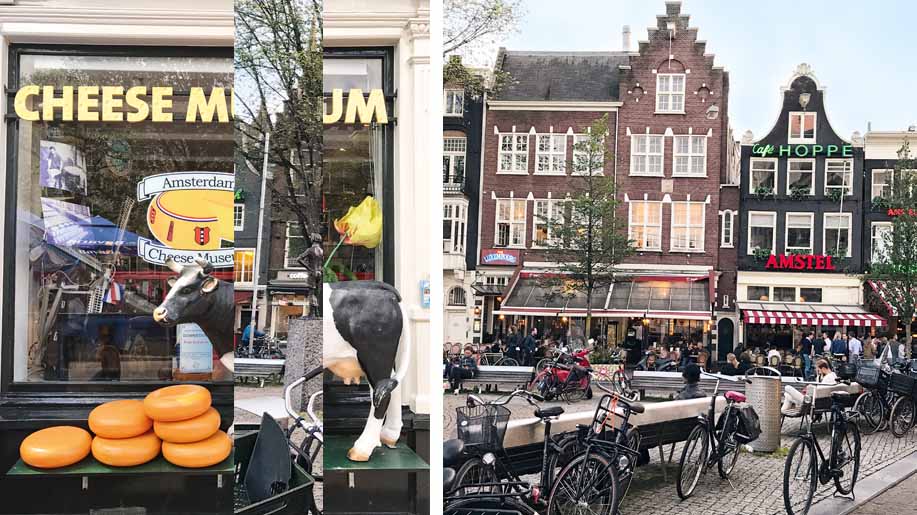
I’m swinging 100 metres above the ground, enjoying an uninterrupted view of Amsterdam. As the evening breeze rustles through my hair, David Bowie sets the mood just right with his version of Port of Amsterdam. His lyrics make me wonder about the stories brought back by sailors pulling into the distant port below me. Could one of the many narrow streets that stretch out from here be the boisterous red light district that Bowie vividly sings about? I think about what part of this cityscape serves the best raw herring that is loosely mentioned in the song, albeit unappetisingly.
This sweet preview of the city continues as I make my way down to Madam from the aforementioned swing on the observation deck of A’DA Toren, A’DAM Lookout (open daily 10:30am-9pm; €12.50/₹957; adamlookout.com). Madam (open daily noon-4:30pm, 6pm-12:30am and until late on weekends; madamamsterdam.nl) is the glass-walled “panorama bar and restaurant” on the 20th floor of the tower. The swing is on its roof.
Up until 10pm Madam is a casual dinner venue, after which the lights are dimmed down to welcome its guests looking to party. Though the nightclub has its own allure, as a first-time visitor to Amsterdam, I personally enjoyed the bar better when the sky was bright and the place was less crowded. The panorama of Amsterdam through its glass walls are simply breathtaking. At night, it’s like any other crowded city bar.

FLAVOUR
My tour of Amsterdam begins with an Uber ride to Albert Cuypstraat (open Monday-Saturday, 9am-5pm; albertcuyp-markt.amsterdam). It’s around 10:30am and vans are pulling out from the pedestrian-only street after quickly offloading at the stalls. The pavements are lined with kiosks vending edibles, cheap souvenirs and fresh flowers. On the footpath behind these kiosks, there are local boutiques selling everything from clothing to utensils and soft furnishings to name a few. To be honest, they aren’t really worth a visit, for the quality is poor. The food stalls though, especially warm the the hearts of foodies looking for “home cooked ” Dutch meals.
My hotel’s receptionist had assured me that this market would be the best place for authentic raw herring, at the same time warning me of it being an acquired taste. And the pickled delicacy is indeed two notches too piquant for my liking.
Amused by the show of expressions on my face, a Dutch lady working a stroopwafel stall beckons to me for a change of taste. She makes balls from freshly kneaded sweetened flour dough before flattening them under a rolling pin. Warm out of the waffle iron, she slathers a thick layer of flavoured melted sugar between two toasted discs. It tastes just as it looks — a burst of caramel, much needed to overpower the fishy aftertaste from the raw herring.
I take a seat on the pavement and watch as the market gets increasingly crowded within the hour. There are more tourists than locals here. Of course, this isn’t the only recommended market in the city. The reason it is more popular amongst tourists is firstly because of the array of cooked Dutch foods it offers, and secondly because of its proximity to The Heineken Experience.
The other popular markets, such as Noordermarkt and Nieuwmarkt, are better known for raw meat, fruits and vegetables, and a few cheese stands. You’ll find different sizes of cheese wheels at Albert Cuypstraat too, but reserve the tasting for the Cheese Museum, which I will speak about later.

I continue biting into my sugar treat as I walk all of five minutes to The Heineken Experience (open daily 10:30am-7:30pm, until 9pm Friday-Sunday; tickets €16/₹1,225 onwards; heineken.com). Expect hordes of tourists here; having said that, it’s still a fun visit. I book the VIP tour (€49/₹3,753) that opens with a dramatic audio-visual presentation of the brand’s history. It takes you through the indoor stable beside which is the mock brewery. Here you can “work” the machinery for beer production and feel the raw ingredients. The next stop is at its bar where you toast to the experience, before heading to the second one on the rooftop. This is where you can avail of the coupon for a free beer, while enjoying a bird’s-eye view of the city from its balcony. Along the way is a gaming arena where you can play against computerised screens and take selfies against neon-lit Heineken backdrops. To help immortalise your memory of the visit there is a “vending” machine where you can customise the label on your beer bottle. Finally, you exit through the gift shop. And this exit, quite dramatically is the entry to my next venue.
If you know of Banksy, you’ll make the connection. He is an England-based graffiti artist, political activist and film director whose work includes Exit Through the Gift Shop, a documentary that exemplifies the ordeal of graffiti artists. About a 12-minute walk from The Heineken Experience, Banksy: Laugh Now is running until May 31 at Moco Museum (open daily 10am-6pm, tickets €12.50/₹957; mocomuseum.com). What makes this exhibition special is that this is the first time a museum has Banksy’s art, neatly framed, on display. They’re a collection of his past work — burlesque depictions of political and social happenings. Before departing, I flip through bundles of his prints at the gift shop to choose for my own collection — I pick Flower Thrower.
With this, my first day of touring Amsterdam comes to an end. It is 6pm and my activity tracker congratulates me for exceeding the 10,000-step mark long before my legs beg for a rest.
I take a 25-minute Uber ride to van Kerkwijk (open daily 11am-until late; caferestaurantvankerkwijk.nl) for a quiet, inexpensive dinner. I’m greeted with a whiff of freshly baked pies placed on a counter by the door. At the entrance of the cosy cafe, the menu is scribbled in chalk alongside prices on the wall, for those who aren’t regulars. Diners aren’t given menus. One of the two van Kerkwijk sisters, the owners, rattles off the dishes on offer that day to guests. There are about four each of starters and main courses, and two desserts to choose from.
It’s a busy night with many crowding the tiny bar, while waiting for an empty table from the occupied ten that seat a total of about 30 people at a time. Myra, my server for the evening greets me with a smile. Today is her sister’s day off, but that doesn’t stop the clearly overworked hostess from repeating the dishes with a smile, to the indecisive me. I start with the smoked salmon with tuna mousse and finish with a pear pie. Satiated, I call it a day.

SIGHT
The next day I wake up to a sunny sky — perfect to begin with a stroll along the canals and over footbridges of 9 Straatjes (nine little streets) in Jordaan, a district in the city centre. It was formed by European refugees who migrated here in the 17th century. During its structural restoration in the 20th century, artists and designers gave the neighbourhood a creative facelift. Today, it is filled with ancient row houses, quirky boutiques and quaint cafes.
It is here where I notice Amsterdam’s structural appearance for what it really is — askew. One of the many theories that explains this oddity, and the one I find most logical is based on the city’s foundation. It is built on stilts lodged deep into clay and peat used to reclaim land. Over time, the structures, and most likely the entire city tilted due to uneven sinking of these poles. This, I learn later in the day from one of the staff at Amsterdam Museum (open daily 10am-5pm; tickets €12.50/₹957; amsterdammuseum.nl). The interactive educational centre is truly worth a visit for a quick, awe-inspiring lesson of the Dutch capital’s history. It believes that Amsterdam is “based on the four core values of entrepreneurship, free thinking, citizenship and creativity”, and strongly highlights these codes through its displays.
During my stroll through Jordaan, I stumble upon a shop no more than 225 square feet. Its wooden interiors painted in white are covered with rows of rubber ducks. Some pose in costumes, while others look cute in fashion accessories. Amsterdam Duck Store (open daily 10:30am-6:30pm; amsterdamduckstore.com) is enticing even for adults. I’ve spent nearly 45 minutes browsing through the vast collection, and am forced to make a quick decision after the cashier politely asks which of the ducks would I like to purchase. I choose five as gifts and three for myself, one amongst which is a duck dressed as an elephant!
I map my stroll to end at Amsterdam Cheese Museum (open daily 9am-7pm; cheesemuseumamsterdam.com). It isn’t much of a museum per se, but a haven for cheese lovers who can sample the varieties on offer to their heart’s content. The prices are competent too. Start at the basement crowded with ancient cheese-making equipment, posters revealing statistics of Dutch cheese production, and a prop booth where one can dress as a farmer of yore for pictures. It is on the main floor of this compact space where all the cheese is stacked, and samples are lined up for free tasting. From the smokey Gouda to the authentic Cheddar, my favourite is the Heineken-flavoured cheese, less because of the taste and more for its uniqueness.

Next door to this is Amsterdam Tulip Museum (open daily 10am-6pm; amsterdamtulipmuseum.com). Again, this isn’t really a museum, but more of a store that sells seeds and trimmings from a number of flowers and plants, including tulips. By the entrance are temporary flower beds, which the staff tends to. Flora is neatly arranged on long wooden frames placed in an orderly manner on the shop floor. On the walls one will find literature on tulip varieties and how Amsterdam came to be known for this flower. The gardeners here are just as friendly as their “cheesy” neighbours in helping me pick the right flowers to plant back home.
Continuing on my luck with store-styled “museums”, I stumble upon Cow Museum (open daily 12pm-10pm; cowmuseum.amsterdam) on my walk back to the hotel. It is a visual art project where large cow sculptures are painted and sold to collectors, proceeds of which are given to charity. The smaller bovines, along with other miniatures of Disney characters and comical statues are sold in the store. Go in just for a smile if for nothing else.
A weekend well spent, I return to the hotel to pack memories of my quick Dutch sojourn — rubber ducks in disguise, cheese, personalised Heineken bottles, a Banksy print and a tulip shaped fridge magnet. Amsterdam is one of those cities that has something new to discover each time you go back. Having limited time on hand, I consciously skip the usual red light district, “I Amsterdam” sign, and museums (Rijksmuseum, Anne Frank House and Van Gogh museum — advisable to prebook tickets online to avoid long queues), leaving them for a longer visit.
On my next trip to the city, it will not only include time at the usual tourist spots, but also at some of the lesser known attractions such as free concerts at The Royal Concertgebouw in Museumplein on Wednesday afternoons, ice skating on the roof of Ramada Apollo Hotel in Rembrandtpark, palm-sized houses stacked between addresses 54 and 70 to make up for the missing numbers on Noordermarkt, and Fruittuin van West where you can pick your own fruit from the trees!












